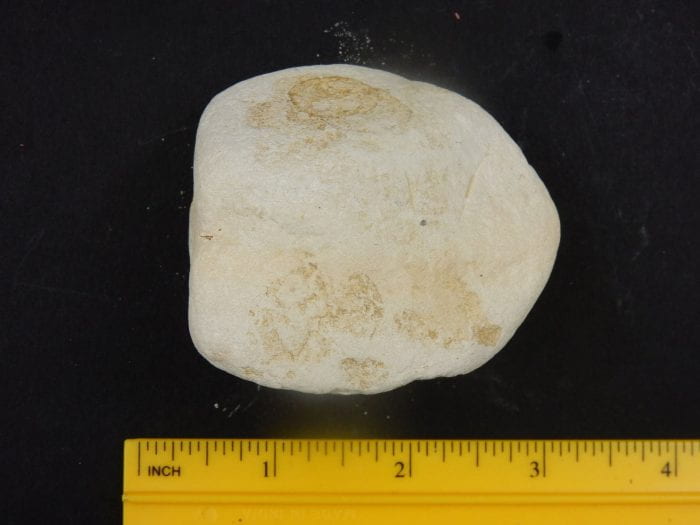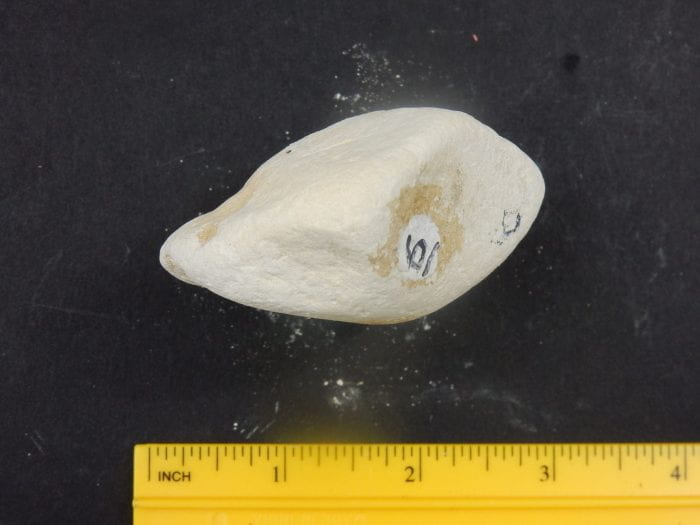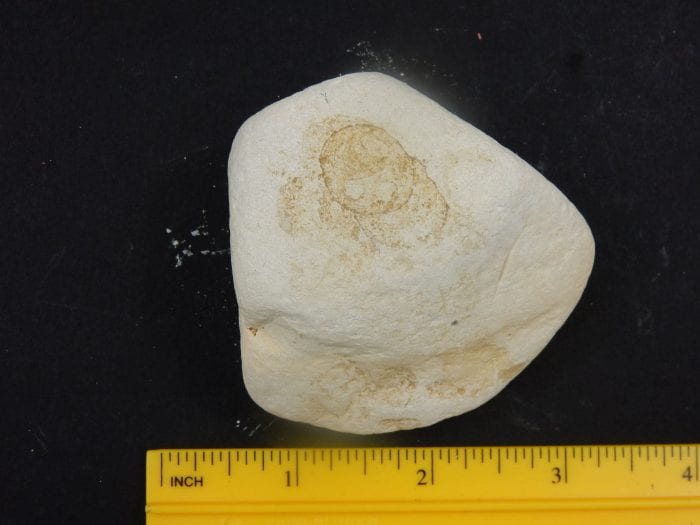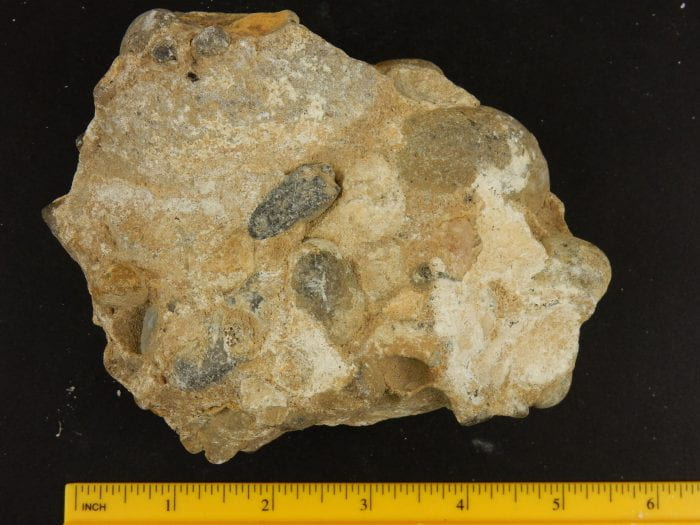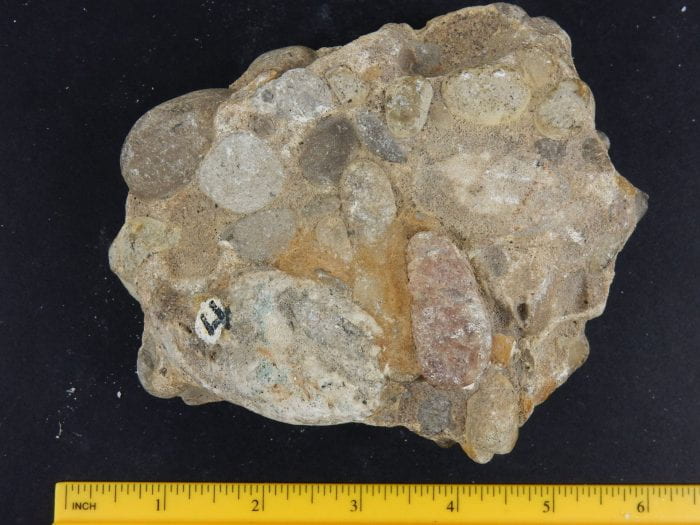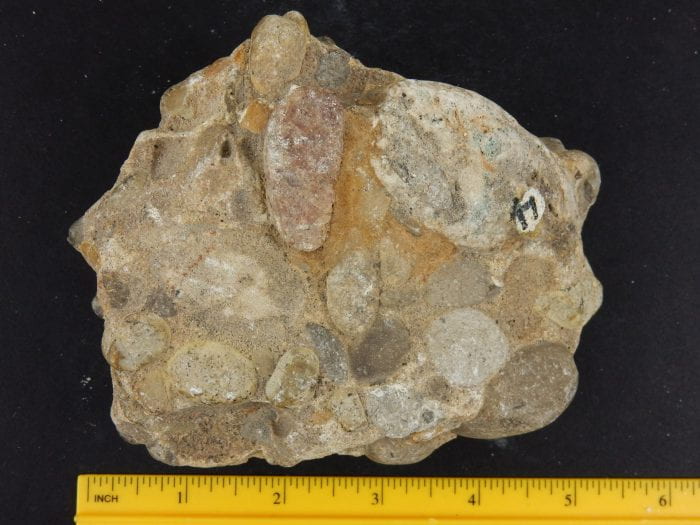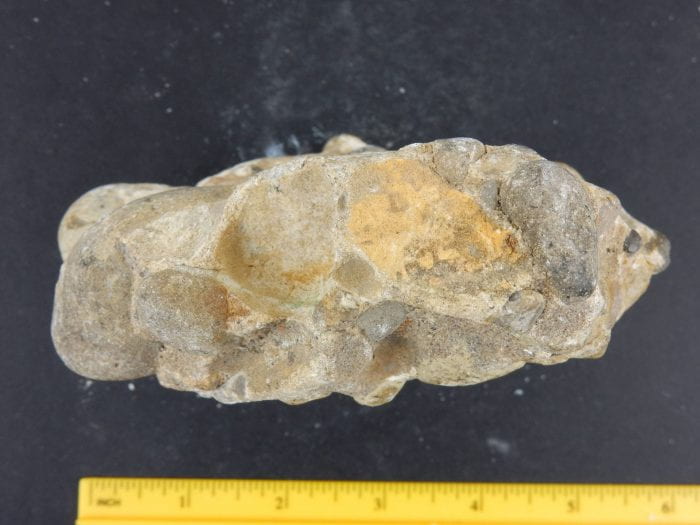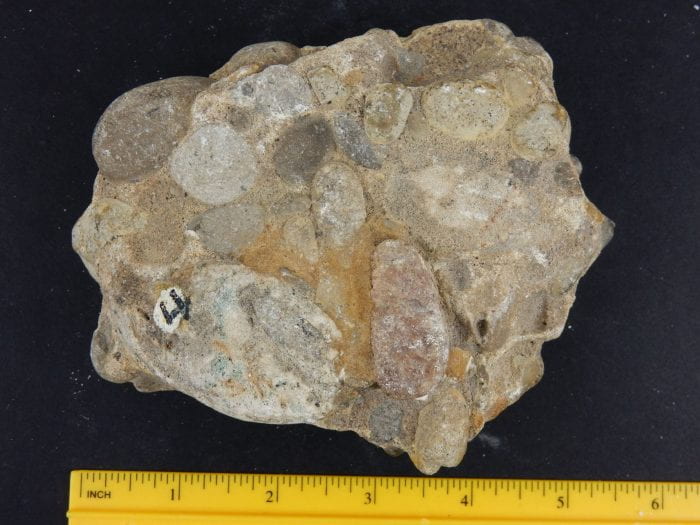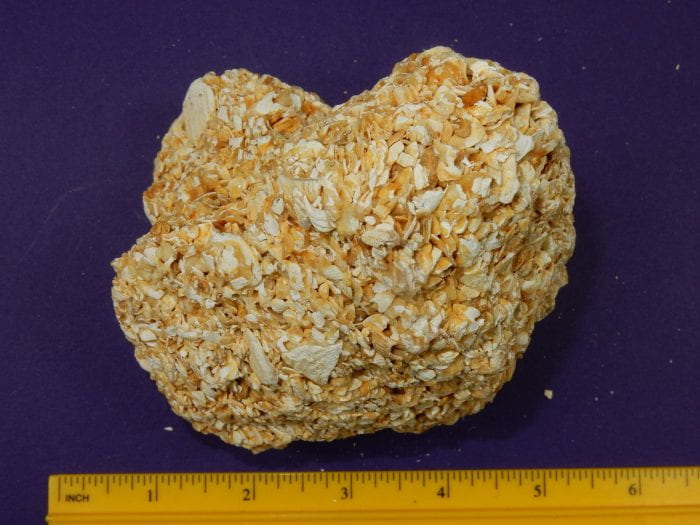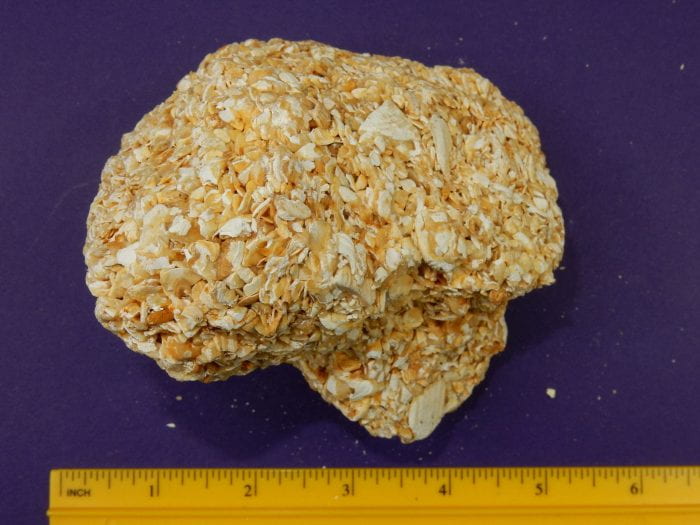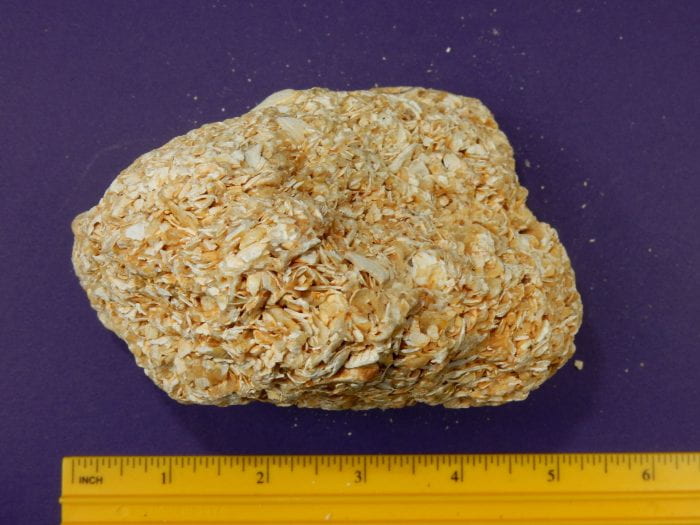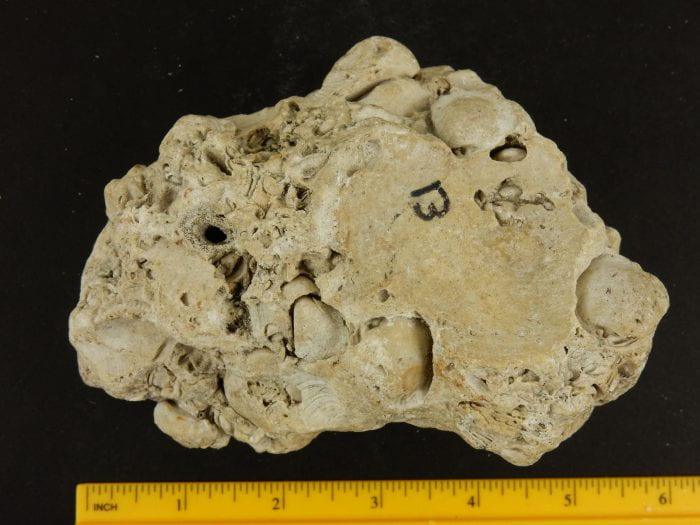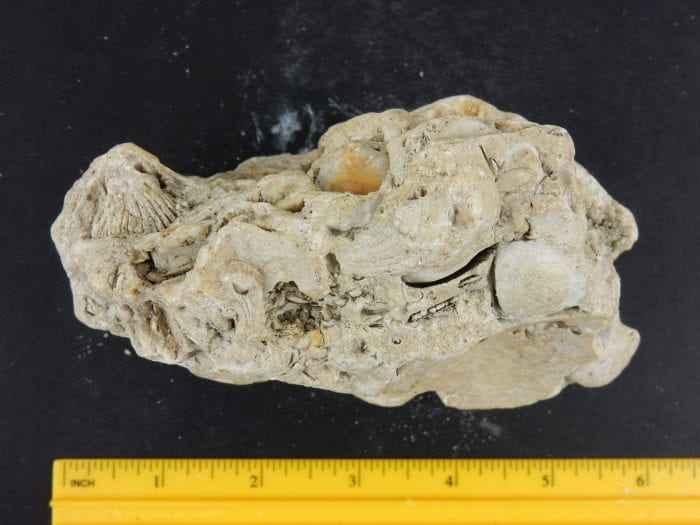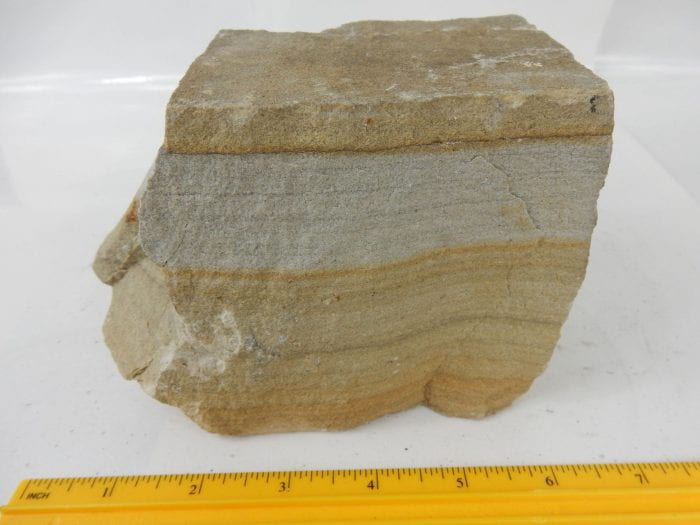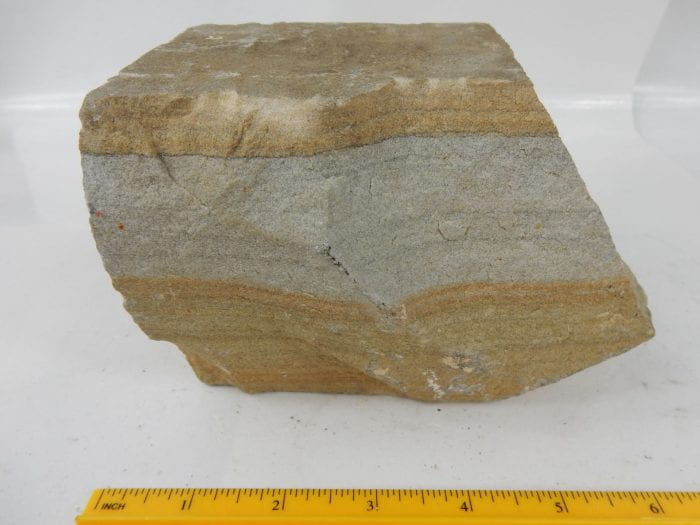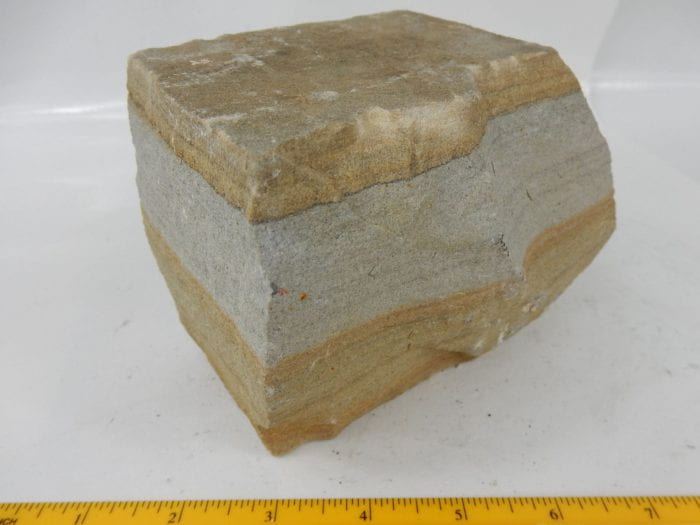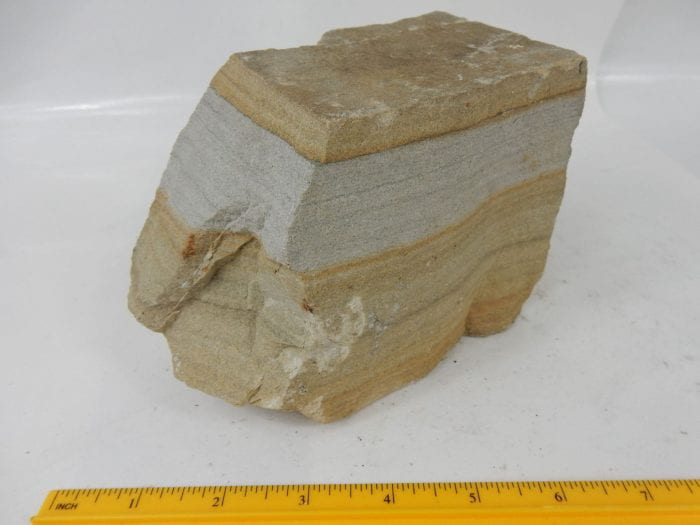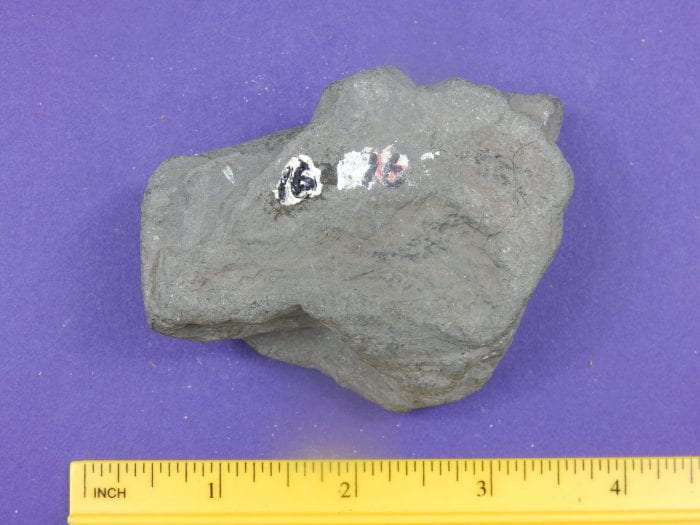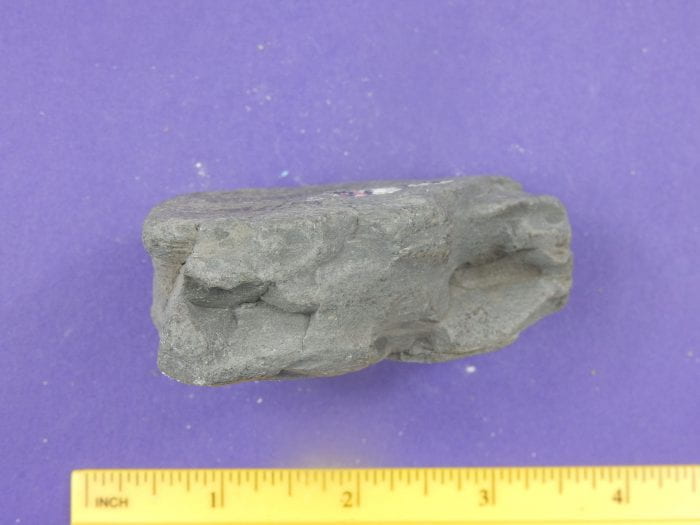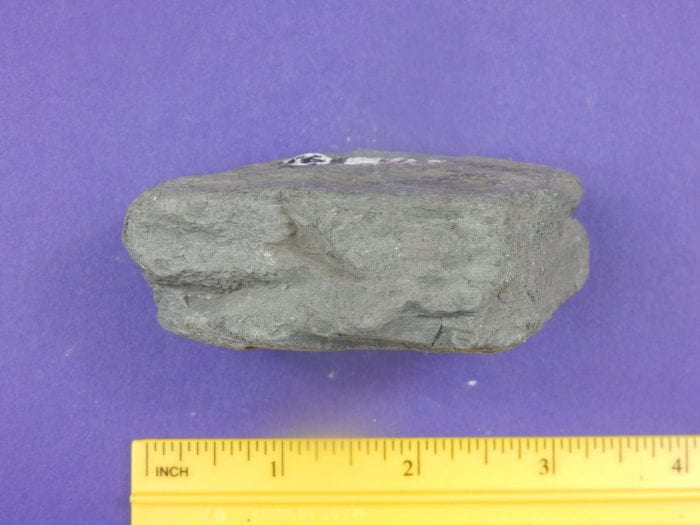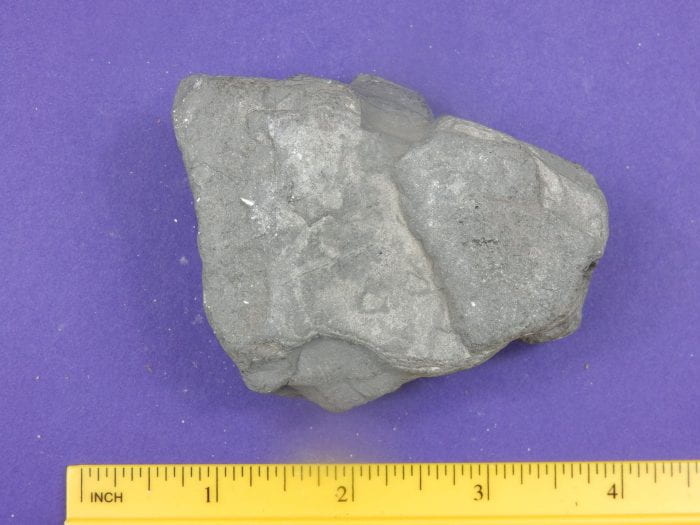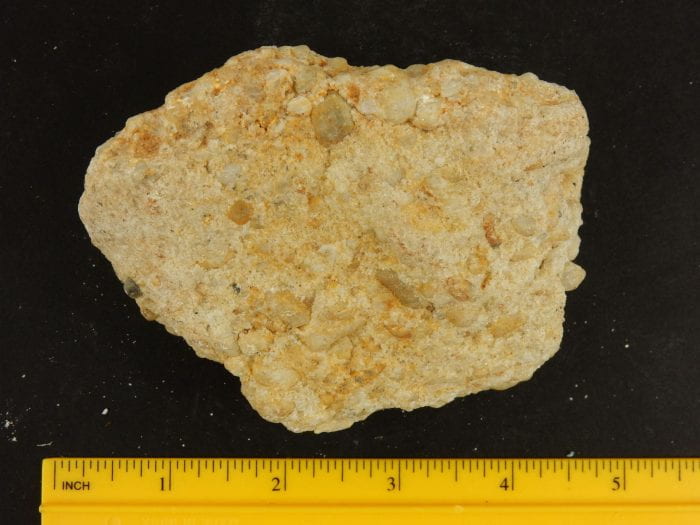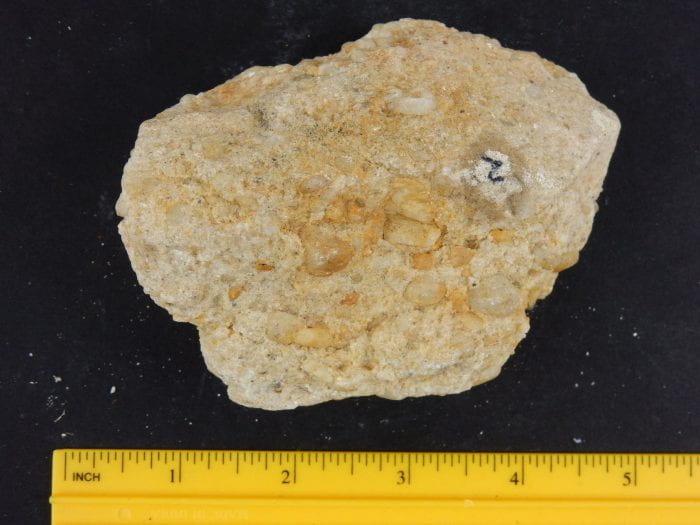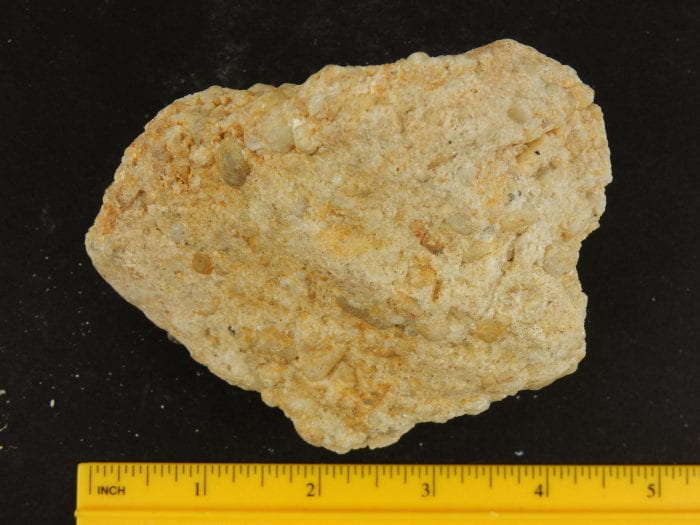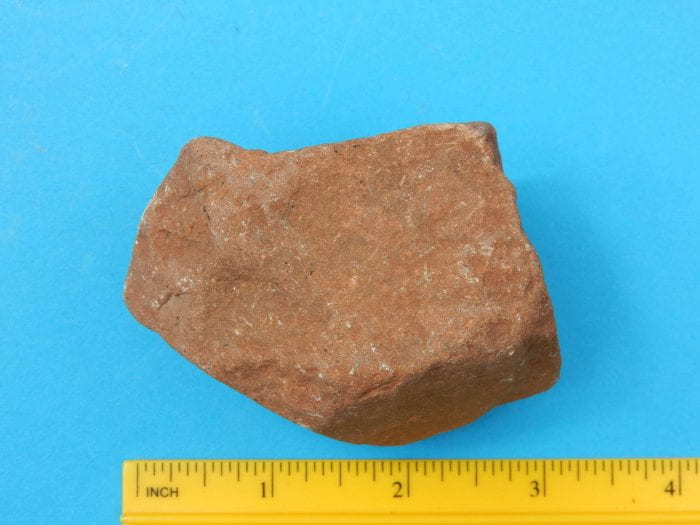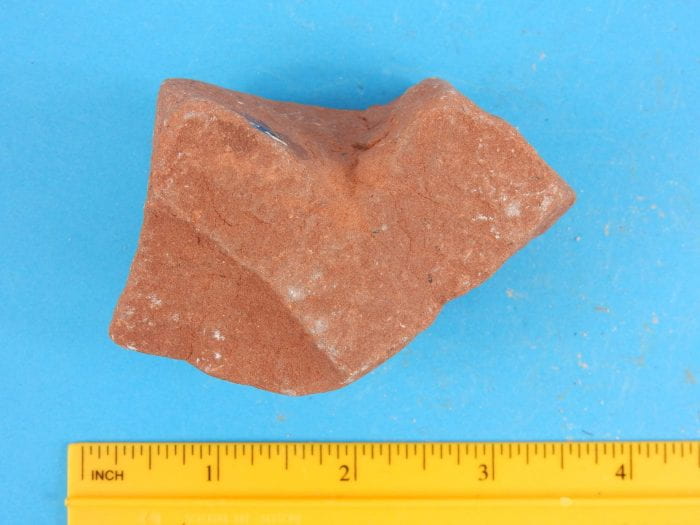Sedimentary Rocks Gallery
Select or click a sedimentary rock name to view photos and some facts about the rock.
Breccia
Sample shows lithic (rock) fragments that are angular in shape surrounded by a matrix of finer grains.
Classification: Detrital
Depositional Environment: Transitional, water
Texture: Coarse-grained texture. Large (>2mm) angular clasts surrounded by a matrix of smaller grains.*** Bedding structure present on a large scale.
Common Minerals: Wide range of minerals and rock fragments. Breccias can have clasts from a wide variety of sources and can contain metamorphic, igneous, or sedimentary rock fragments.
Interesting Facts: As a result of its varied appearance, breccias have been used for jewelry, statues, decorative tile, and even sculptures.
Bituminous Coal
Sample shown exhibits the characteristic dense fine grained texture and black color of bituminous coal.
Classification: Bio-chemical
Depositional Environment: Continental
Texture: Fine grained organic matter
Common Minerals: Carbon
Interesting Facts: Although organic in origin coal is classified as a sedimentary rock and is formed when pressures from geologic processes result in the transformation of buried plant matter to coal. Coal is used primarily to produce electricity. However, when burned, its byproducts can also be used in the manufacture of steel, plastics, and paint.
Carbonate Mudstone
Sample shows homogenous fine-grained nature of mudstone. The white color is reflective of the dominant mineral calcite (Calcium Carbonate).
Classification: Chemical
Depositional Environment: Marine
Texture: Fine grained (individual grain size <0.004mm)
Common Minerals: Calcite (calcium carbonate)
Interesting Facts: This mudstone can form from direct precipitation of minerals in a marine environment.
Conglomerate
Sample shows large rounded to sub rounded clasts (rock fragments) within a finer grained matrix.
Classification: Detrital
Depositional Environment: Continental (river)
Texture: Coarse-grained texture. Large (>2mm) rounded clasts surrounded by a matrix of smaller grains.
Common Minerals: Wide range of minerals and fragments. Conglomertes can have clasts from a wide variety of sources and can contain metamorphic, igneous, or sedimentary rock fragments.
Interesting Facts: Conglomerates can be useful in diamond prospecting. If the conglomerate contains clasts of Kimberlite, an igneous rock that hosts many diamond deposits, then a source is likely located upstream!
Coquina
Coquina is formed from lithified shells and shell fragments of marine organisms. The sample shown is composed of cemented Mollusk shell fragments.
Classification: Bio-chemical
Depositional Environment: Transitional marine (beach, tidal channels, barrier islands)
Texture: Course grained
Common Minerals: Calcite (calcium carbonate), aragonite
Interesting Facts: The fortress walls at Castillo de San Marcos in St. Augustine, Florida were built in 1672 with blocks cut from exposed coquina.
Fossiliferous Limestone
Fossiliferous limestone is formed in a marine environment where fragments of microscopic and macroscopic marine organisms is abundant. The sample shown is composed of cemented bivalve shell fragments in a fine-grained matrix.
Classification: Bio-chemical
Depositional Environment: Marine
Texture: Large bioclasts in a medium to fine grained matrix
Common Minerals: Calcite (calcium carbonate) and aragonite.
Interesting Facts: Fossiliferous limestone can have evidence of organisms that have gone extinct like ammonites (extinction – end of the Cretaceous period about 66 million years ago) and trilobites (extinction – end of the Permian period about 252 million years ago).
Laminated Limestone
Sample shows the small scale (<1cm thick) nature of sedimentary layers defined as lamination. Grains are calcium carbonate in composition.
Classification: Chemical
Depositional Environment: Marine, continental
Texture: Fine grained
Common Minerals: Calcium carbonate (calcite and/or aragonite)
Interesting Facts: These limestones can form in deep water marine environment or in inland lakes.
Mudstone
Sample is composed of fine grained (mud sized) clasts. Clasts are derived from a terrigenous (land based) source.
Classification: Detrital
Depositional Environment: Marine, freshwater
Texture: Fine grained well sorted grains
Common Minerals: May contain Calcite (Calcium carbonate)
Quartz Conglomerate
Sample composed of rounded clasts of quartz surrounded by a finer grained matrix.
Classification: Detrital
Depositional Environment: Fresh water, marine
Texture: Coarse-grained texture. Large (>2mm) rounded clasts surrounded by a matrix of smaller grains.
Common Minerals: Predominantly Quartz clasts
Sandstone
Sandstones display a range of colors. Sample is composed of sand sized grains derived from a terrigenous (land based) source. The red color of the sample shown is as result of the high iron oxide content. Not all sandstones are red in color.
Classification: Detrital
Depositional Environment: Continental, marine
Texture: Medium grained. Well sorted, rounded to angular clasts.
Common Minerals: Quartz, Feldspar
Interesting Facts: Sandstones are predominantly formed by lithification of quartz grains. This makes them useful as an abrasive. Many grindstones used for sharpening blades are made from sandstone.
References and Glossary
Sedimentary rocks are classified in two groups
| Detrital Sedimentary Rocks | form from solid particles weathered from other rocks |
| Chemical and Biochemical Sedimentary | form from ions carried in solution |
Classes of clastic sediment and associated sedimentary rock
| Particle Size | Sediment | Rock |
|---|---|---|
| COARSE Larger than 256 mm 256-64 mm 64-2 mm | GRAVEL Boulder Cobble Pebble | Conglomerate |
| MEDIUM 2-0.062 mm | SAND | Sandstone |
| FINE 0.062-0.0039 mm | MUD Silt | Siltstone |
| Finer than 0.0039 mm | Clay | Mudstone (blocky fracture) Shale (breaks along bedding) Claystone |
References
- Geology.com (2021). Coal. [online] Available at: https://geology.com/rocks/coal.shtml
- Pellant, C. (1992). Rocks and minerals. 1st American ed. New York: Dorling Kindersley

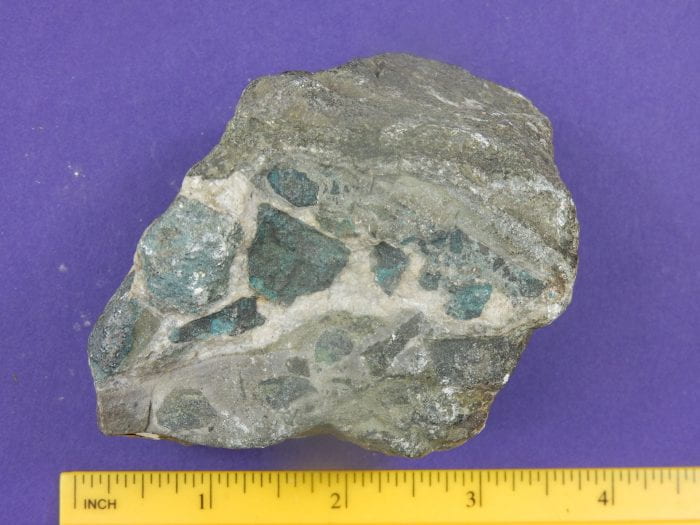
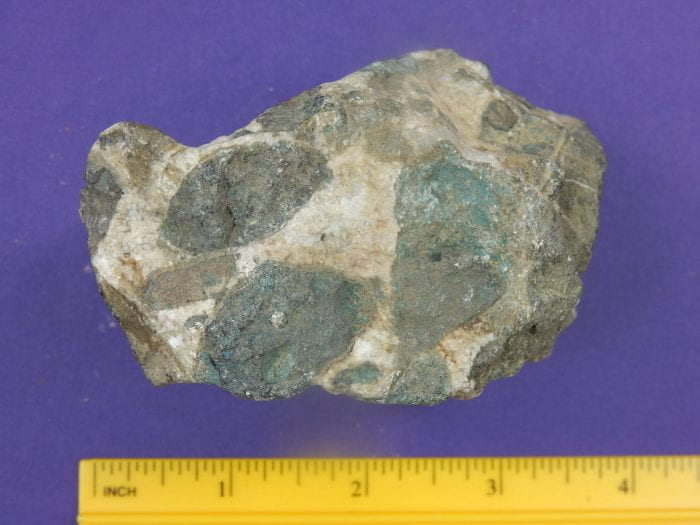
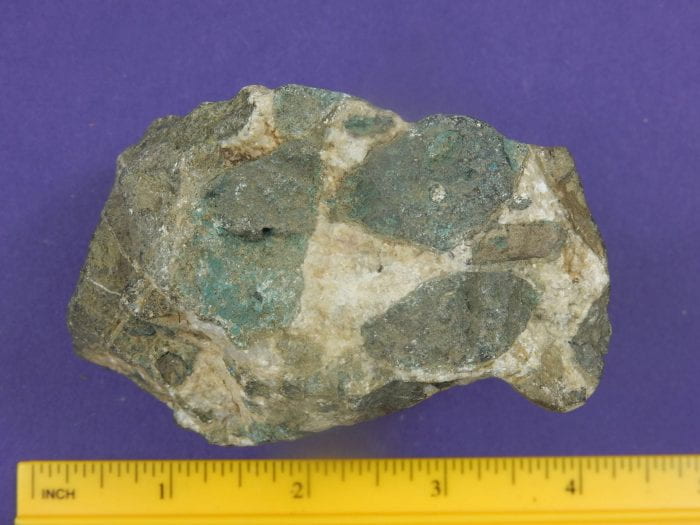
![Bituminous Coal DSCN2959[1] Bituminous Coal](https://sites.broward.edu/science-wellness-north/files/2021/02/DSCN29591.jpg)
![Bituminous Coal DSCN2967[1] Bituminous Coal](https://sites.broward.edu/science-wellness-north/files/2021/02/DSCN29671-scaled.jpg)
![Bituminous Coal DSCN2966[1] Bituminous Coal](https://sites.broward.edu/science-wellness-north/files/2021/02/DSCN29661.jpg)
![Bituminous Coal DSCN2960[1] Bituminous Coal](https://sites.broward.edu/science-wellness-north/files/2021/02/DSCN29601-scaled.jpg)
